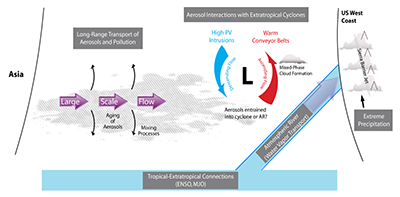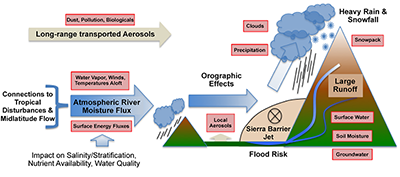|
CalWater2 Science Goals

|
|
CalWater Observables

|
Click images for more detail |
Overview
CalWater2
Proposed Deployment: January through March 2015
A better understanding of Atmospheric Rivers (ARs) and Aerosols is needed to reduce uncertainties in weather predictions and climate projections of extreme precipitation and its effects, including the provision of beneficial water supply. In the CalWater2 White Paper, science gaps are identified associated with (1) the evolution and structure of ARs, (2) the prediction of aerosol burdens and properties during intercontinental transport from remote source regions to the U.S. West Coast, and (3) aerosol interactions with ARs and the impact on precipitation, including locally generated aerosol effects on orographic precipitation along the U.S. West Coast. A set of science investigations are proposed to fill these gaps with a targeted set of aircraft and ship-based measurements and associated evaluation of data over regions offshore of California and in the central and eastern Pacific for an intensive observing period.
Expected Outcomes:
A better understanding of Atmospheric Rivers (ARs) and Aerosols is needed to reduce uncertainties in weather predictions and climate projections of extreme precipitation and its effects, including the provision of beneficial water supply. In the CalWater2 White Paper, science gaps are identified associated with (1) the evolution and structure of ARs, (2) the prediction of aerosol burdens and properties during intercontinental transport from remote source regions to the U.S. West Coast, and (3) aerosol interactions with ARs and the impact on precipitation, including locally generated aerosol effects on orographic precipitation along the U.S. West Coast. A set of science investigations are proposed to fill these gaps with a targeted set of aircraft and ship-based measurements and associated evaluation of data over regions offshore of California and in the central and eastern Pacific for an intensive observing period.
Expected Outcomes:
- Improvements in prediction systems for weather and climate,
- Distribution of an unprecedented meteorological and chemical dataset collected in AR environments both onshore and offshore, and
- Development of decision support tools for extreme precipitation events and water supply for more effective water resources management.
CalWater1
Deployment: Winters 2009-2011
In an effort to identify the key gaps in our knowledge and develop the most effective strategies to address them, science leaders from the California Energy Commission, NOAA, and Scripps Institution of Oceanography at the University of California, San Diego came together in 2008 to explore how to proceed, to take advantage of the infrastructure and knowledge gained through NOAA's Hydrometeorology Testbed (HMT) efforts in California, and aid the CEC planning for a possible follow-up Public Interest Energy Research (PIER) field study of the role of aerosols on orographic precipitation.
Read more....
In an effort to identify the key gaps in our knowledge and develop the most effective strategies to address them, science leaders from the California Energy Commission, NOAA, and Scripps Institution of Oceanography at the University of California, San Diego came together in 2008 to explore how to proceed, to take advantage of the infrastructure and knowledge gained through NOAA's Hydrometeorology Testbed (HMT) efforts in California, and aid the CEC planning for a possible follow-up Public Interest Energy Research (PIER) field study of the role of aerosols on orographic precipitation.
Read more....